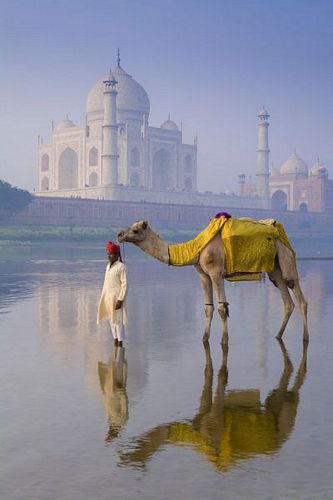Ayodhya, a city steeped in history and religious significance, is a place that captivates the hearts of millions of visitors each year. With its rich cultural heritage and spiritual allure, Ayodhya stands as a symbol of India's diverse and ancient traditions. In this travel guide, we will explore the enchanting places to visit in Ayodhya, offering you a comprehensive glimpse into the city's tapestry of spirituality, history, and architecture.
Ram Janmabhoomi:
At the heart of Ayodhya lies the revered Ram Janmabhoomi, the birthplace of Lord Rama. This sacred site holds immense significance for Hindus and is a focal point of devotion. The Ram Janmabhoomi complex includes the historic Babri Masjid site, where the iconic Ram Mandir is being constructed. Pilgrims from across the globe visit this spiritual epicenter to seek blessings and immerse themselves in the divine atmosphere.
The Ram Mandir, designed with intricate architecture, will be a testament to India's architectural and religious heritage. As the construction progresses, it becomes a symbol of unity and faith for the millions who hold Lord Rama in their hearts.
Hanuman Garhi:
Perched atop a hill, Hanuman Garhi is a fortress-like temple dedicated to Lord Hanuman. The temple offers panoramic views of Ayodhya, creating a serene and tranquil ambiance. Devotees flock to this sacred spot to seek the blessings of Lord Hanuman, who is venerated for his unwavering devotion to Lord Rama.
Legend has it that Hanuman Garhi was established by a sage in the 10th century, making it not only a religious site but also a historical marvel. The climb to the temple is rewarded with breathtaking vistas, making it a must-visit for both spiritual seekers and nature enthusiasts.
Sita Ki Rasoi:
A visit to Ayodhya is incomplete without exploring Sita Ki Rasoi, which translates to "Sita's Kitchen." This ancient site is believed to be the kitchen where Goddess Sita cooked meals during her stay in Ayodhya. The architecture and design of Sita Ki Rasoi provide a glimpse into the lifestyle of that era.
The significance of Sita Ki Rasoi lies in its association with the Ramayana, one of the epic tales of Hindu mythology. Pilgrims often participate in rituals and prayers here, connecting with the divine energy that permeates the surroundings.
Kanak Bhawan:
Kanak Bhawan, also known as Sone Ki Chidiya, is a splendid temple dedicated to Lord Rama and Goddess Sita. The temple is renowned for its golden interiors, exquisite carvings, and vibrant frescoes. Devotees believe that the idols of Lord Rama and Goddess Sita in Kanak Bhawan were gifted to them by Lord Rama's stepmother, Kaikeyi, during their wedding.
The temple's architecture is a testament to the artistic brilliance of the craftsmen of that era. Visitors are not only drawn to the divine presence within but also to the intricate detailing that adorns the walls and ceilings.
Treta Ke Thakur:
Treta Ke Thakur is a temple dedicated to Lord Rama and is believed to be the spot where Rama performed the Ashvamedha Yajna. The temple, surrounded by lush greenery, exudes a serene atmosphere, providing visitors with a peaceful place for introspection and prayer.
The ancient vibes of Treta Ke Thakur make it a unique destination for those seeking a connection with the mythical era of the Ramayana. The temple's architecture and the spiritual aura make it a must-visit for devotees and history enthusiasts alike.
Nageshwarnath Temple:
Nageshwarnath Temple is one of the oldest temples in Ayodhya, dedicated to Lord Shiva. According to legends, Lord Rama himself installed the Shiva Lingam here before embarking on his journey to Lanka. The temple's architecture reflects a blend of historical and cultural influences.
The sanctity of Nageshwarnath Temple draws devotees who seek Lord Shiva's blessings. The temple's courtyard, adorned with intricate carvings and sculptures, transports visitors to a bygone era, making it a place of both religious and historical significance.

Uttar Pradesh
Uttar Pradesh is a state located in the northern part of India. It is the most populous state in India, with a population of over 200 million people. The state is known for its rich history and culture and is often referred to as the "Heartland of India". The state has a total area of 243,286 square kilometers and is bordered by the Indian states of Uttarakhand, Himachal Pradesh, Haryana, Rajasthan, Madhya Pradesh, Chhattisgarh, Jharkhand, and Bihar. Lucknow is the capital of Uttar Pradesh.
Ayodhya
A very ancient religious city situated on the Saryu River bank, it is also called kaushal country. The city of Ayodhya is quoted as the birthplace of Bhagban Ram. It has been counted on the ancient India Saptakpuris (first) . The present temples are Sitasoi and Hanumangarh main. According to Sandpurana, the city is on the Sudarshan Chakra, . The scenic spots are mainly Laxmanghat, Sunder Gate Ghat, Ahiyabai Ghat, Kanak Bhawan, The pilgrimage of the vicinity of Philosophy, Dasrath Tirtha, Dasrath Tirtha, Chapaiya, Nandigram, Sonkhar, Surya Kund, Guptarghat, Janora etc. .
Nageshwarnath Temple
The Nageshwarnath Temple is a prominent Hindu temple located in the city of Ayodhya in Uttar Pradesh, India. The temple is dedicated to Lord Shiva and is believed to have been built during the 7th century by King Kush, son of Lord Rama. The temple is situated on the banks of the River Sarayu and features a unique architecture that reflects the influence of various dynasties that ruled the region over the centuries. The main shrine of the temple houses a Shiva Lingam, and the temple complex also includes several other shrines dedicated to various deities. The temple is considered to be one of the holiest places in Ayodhya and attracts a large number of devotees throughout the year.